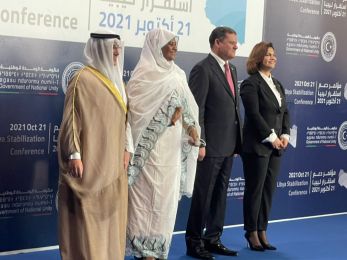PANAPRESS
Panafrican News Agency
India: African Economic Outlook says 'Intra-African trade is key to sustainable development'
Ahmedabad, India (PANA) - Trade between African countries has the greatest potential for building sustainable economic development and integration, according to the African Economic Outlook (AEO) 2017, a flagship report of the African Development Bank (AfDB), released in Ahmedabad on Day 1 of its 52nd Annual Meetings in the Indian city.
Citing data produced by its economists and peer institutions, the report said trade among African countries expanded from 10% in 2000 to about 16% in 2014, reflecting the continent’s recent economic upturns.
Africa’s GDP and its internal trade expanded fourfold over the past two decades, according to the report, which suggests that that intra-African trade is more resilient than exchanges with other regions of the world, largely because manufactured goods are less susceptible to price shocks which affect primary products that constitute over 50% of trade between the continent and other countries.
The report also cited low manufacturing and processing capacity as a major limiting factor for trade among African countries, saying that Intra-African trade in manufacturing declined from 18% in 2005 to about 15% between 2010 and 2015.
Most of Africa’s primary exports undergo little processing before they are re-exported, the report argues, citing cocoa beans from Côte d’Ivoire and Ghana and crude oil and petroleum products from Nigeria as examples.
“Petroleum exports from Africa to the rest of the world stood at US$85 billion, yet Africa’s fuel imports from outside the continent ranged between US$63 billion and US$84 billion from 2010 to 2015,” it reads.
Contrary to popular notion, the heterogeneity of national exports helps Intra-African trade as the spread of products across the continent allows for more trade between regions with large food demands.
For instance, resource-rich countries can obtain supplies from countries with more advanced agricultural productivity. Similarly, countries with more advanced manufacturing sectors hold a potential for growth if they can access the larger African market.
“From 2007 to 2015, the continent’s light manufactured goods imports tripled to reach US$260 billion. Africa’s prospects for greater regional trade are also highlighted by its consumer market of nearly one billion people, the rising number of affluent consumers and the increasing mobility of investment capital,” the AEO says.
It further notes that global economic developments, such as the creation the Trans-Pacific Partnership and Africa’s Continental Free Trade Area (CFTA), were likely to strengthen the continent’s appeal as a global trading partner. Similarly, Brexit, Britain’s exit from the European Union, would rather strengthen Africa’s trade ties with Europe than weaken it.
Nonetheless, Africa’s trade and regional integration face several obstacles. These include meeting the needs of the new concept of regionalism which requires a broader approach to reducing administrative and transaction costs and overcoming market segmentation; which pose challenges that require scaling up infrastructure investment to improve connections between and within African countries.
Transportation and communication infrastructure for intra-African trade is less developed than those that connect Africa to the rest of the world, the report says.
-0- PANA VAO/MA 24May2017
Citing data produced by its economists and peer institutions, the report said trade among African countries expanded from 10% in 2000 to about 16% in 2014, reflecting the continent’s recent economic upturns.
Africa’s GDP and its internal trade expanded fourfold over the past two decades, according to the report, which suggests that that intra-African trade is more resilient than exchanges with other regions of the world, largely because manufactured goods are less susceptible to price shocks which affect primary products that constitute over 50% of trade between the continent and other countries.
The report also cited low manufacturing and processing capacity as a major limiting factor for trade among African countries, saying that Intra-African trade in manufacturing declined from 18% in 2005 to about 15% between 2010 and 2015.
Most of Africa’s primary exports undergo little processing before they are re-exported, the report argues, citing cocoa beans from Côte d’Ivoire and Ghana and crude oil and petroleum products from Nigeria as examples.
“Petroleum exports from Africa to the rest of the world stood at US$85 billion, yet Africa’s fuel imports from outside the continent ranged between US$63 billion and US$84 billion from 2010 to 2015,” it reads.
Contrary to popular notion, the heterogeneity of national exports helps Intra-African trade as the spread of products across the continent allows for more trade between regions with large food demands.
For instance, resource-rich countries can obtain supplies from countries with more advanced agricultural productivity. Similarly, countries with more advanced manufacturing sectors hold a potential for growth if they can access the larger African market.
“From 2007 to 2015, the continent’s light manufactured goods imports tripled to reach US$260 billion. Africa’s prospects for greater regional trade are also highlighted by its consumer market of nearly one billion people, the rising number of affluent consumers and the increasing mobility of investment capital,” the AEO says.
It further notes that global economic developments, such as the creation the Trans-Pacific Partnership and Africa’s Continental Free Trade Area (CFTA), were likely to strengthen the continent’s appeal as a global trading partner. Similarly, Brexit, Britain’s exit from the European Union, would rather strengthen Africa’s trade ties with Europe than weaken it.
Nonetheless, Africa’s trade and regional integration face several obstacles. These include meeting the needs of the new concept of regionalism which requires a broader approach to reducing administrative and transaction costs and overcoming market segmentation; which pose challenges that require scaling up infrastructure investment to improve connections between and within African countries.
Transportation and communication infrastructure for intra-African trade is less developed than those that connect Africa to the rest of the world, the report says.
-0- PANA VAO/MA 24May2017






